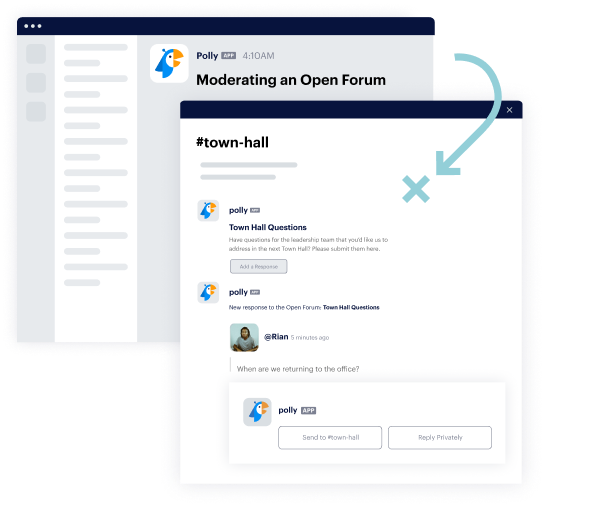We’re not experts in delivering the perfect digital remote, hybrid, or in-office employee experience for every team. Even after over a year spent in the workforce transformation equivalent of a language immersion program, we’re all still learning what works.
We had a head start. We’re small, tech-forward, and nimble. We can turn on a dime. Most members of our team enjoy blazing trails and thrive in ambiguity. As a long-time distributed team, we were ahead of the curve when it came time to go fully remote. We’d already become accustomed to working across time zones and finding creative ways to get things done asynchronously. We’ve got a stack of tools and processes to facilitate all of this.
And while we have made many strides toward a strong digital employee experience for Polly team members across the world, there’s still more to do. That’s why we're continuing to work together, building an environment to support one another no matter where we log in from.
In large part, we can attribute the progress we’ve made together to frequent check-ins, empathy, effort, and active listening. So, how does listening help define our digital employee experience?
How can it help define yours?
1. Get answers to questions you didn’t know to ask.
There’s a challenge with surveys, and it’s not technological. After all, there are more ways to send a survey today than there were even a year ago.
Surveys rely on the sender’s intuition, which is finite. It’s impossible to read the minds of an audience and come up with the perfect set of questions that will reveal every crucial insight.
People often have a predisposition toward rooting out issues they have an immediate capacity to respond to. They gravitate toward fixing problems that rely on their knowledge and influence. In other words, their default isn’t actively listening; but rather waiting to respond.
This is why it’s crucial to consciously develop a continuous cycle of communication. Listening to spontaneous feedback with the goal of understanding where it stems from can lead to better questions, or questions that may never have been asked. Those more insightful questions can help spark more thoughts and spontaneous feedback from others.
Once that flywheel of information sharing begins moving, it gains momentum. As we learn to listen better, we can ask better.
2. Guide a sustainable digital transformation.
Over the early months of 2021, an unexpected phenomenon of employees resigning from their roles emerged. While industries like hospitality were impacted heavily, this trend extended to numerous sectors, including tech.
As NPR’s Andrea Hsu explains:
“Many are rethinking what work means to them, how they are valued, and how they spend their time. It's leading to a dramatic increase in resignations — a record 4 million people quit their jobs in April alone, according to the Labor Department.”If that “Great Resignation” taught us anything, it’s that there are still numerous gaps in understanding regarding employee experience. As many organizations have been rushed through a major transformation with little time to test the waters.
Since 2020, there’s been no shortage of acceleration in digital transformation. 85 percent of executives who took part in a recent McKinsey survey reported they “have somewhat or greatly accelerated the implementation of technologies that digitally enable employee interaction and collaboration, such as videoconferencing and filesharing.“
And while the implementation of those tools and enhancements was necessary to solve an acute need, feedback and employee input are crucial in determining which of these tools fit best, and how to deploy them in the most effective way.
That feedback equally important in understanding other, unforeseen influences digital transformation has on the team’s experience.
As a recent Deloitte report on digital transformation explains:
“No matter what function takes the lead, it’s important to take a “worker-centric” rather than a ‘process-driven’ approach to building a unified experience platform—which means designing the platform around the experience people want to have when they use it, rather than basing its design on the steps of the processes it supports.”
3. Help employees feel valued an accommodated.
Listening speaks volumes. It speaks to your organization’s interest in employee feedback, the value it places on their insights, and a willingness to work toward solving their challenges. This is applicable in numerous organizational structures—small or large, for-profit, non-profit, public or private sector.
As Team Rubicon’s Natasha Medina shares, listening and gathering spontaneous feedback sends a powerful signal to those you work with.
“It shows that we care, too—that we value their input, that we care about their experience and want to improve it.”
While listening and asking good questions can have a strong positive impact on employee sentiment, failing to provide employees with a sense that their feedback is valued doesn’t only miss out on the positive effect, it can create a strong negative effect. Gallup’s Nate Dvorak describes this effect in a recent post why both listening and taking action based on what you learn are critical:
“While leaders can't expect to satisfy everyone, they will appear out of touch with their people's needs if they do not understand and address common concerns and expectations.”
It’s not enough to simply listen, and it’s not enough to take bold action without input from the people that action will impact. Accommodating employee needs effectively requires a combination of listening, asking questions, and taking action based on what you learn.
4. Provide a safe avenue for candid feedback.
Providing a safe space for sharing sensitive or candid feedback is a fundamental step toward better employee outcomes, whether your office is co-located, hybrid, or fully distributed.
It’s not always easy to share your voice publicly, and it can be even more difficult if you’re sharing a dissenting opinion. And while those candid thoughts, ideas, and opinions are notoriously difficult to share, they’re often some of the most valuable. That’s why psychological safety is key to good listening.
Psychologists help patients work through and solve deep challenges by providing an environment where they feel safe to share. Organizations can help employees solve challenges by providing a similar safe environment—one where they’re able to bring the challenges they face out into the open without fear of ridicule or retaliation.
For some employees, having a place to share critical feedback can mean the difference between fostering a safe, inviting, and productive environment for your entire team, or one of quiet, yet pervasive discomfort.
A focus on understanding the needs and concerns of their workforce have an advantage over those who are focused on responding to them, because that understanding is the underpinning of their ability to respond effectively.
How can you implement better listening loops into your digital employee experience?
There are numerous ways you can bring better listening into your employee experience.
- First, take the fundamental step of asking whether the feedback channels in your organization support listening to understand or to respond.
- Second, make sure there are ample avenues for employees to share information and feedback—and that those avenues feel safe.
- Third, validate that feedback, and use it to build a more engaging, safe, and productive environment for your team.
- Finally, make that work visible, so members of the team see the effects of their input being implemented.
We recently released a new type of polly called Open Forum with the goal of making all these steps easier while creating better channels for listening.
Unlike a poll or survey, an Open Forum polly gives employees a safe space that is always available to ask their own questions, share crucial insights, and relay feedback.
Open Forums are a channel for tapping directly into the insights of your team, giving them a place to share ideas for new ways of doing things, raise concerns about vital issues like DE&I, or safety, or bring insightful questions to leadership to help guide the next all-hands meeting.

Open Forum pollys can be public or private, and they’re designed to be flexible so you can capture exactly the information you need, even when you don’t know what to ask.
How about you?
What are some ways you’ve implemented listening and feedback loops in your team? How has that changed over the past year? Let us know at polly_ai





/Internal%20Comms%20Fun%204.png)
/Ask%20questions%20fun%204.png)





